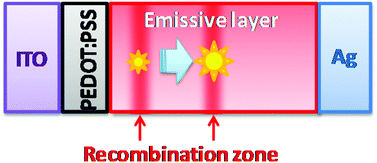Improving the carrier balance of light-emitting electrochemical cells based on ionic transition metal complexes
Abstract
Recently, solid-state light-emitting electrochemical cells (LECs) based on ionic transition metal complexes (iTMCs) have attracted much research interest since they have the advantages of a simple device structure, a low operation voltage and compatibility with air-stable electrodes. These properties enable LECs to be cost-effective, versatile and power-efficient organic light-emitting sources. However, it is generally not easy to modify the molecular structure to achieve balanced carrier mobilities without altering the photoluminescence quantum yield of the iTMC. Furthermore, the carrier balance and the consequent device efficiency of single-layered LECs would not be easy to optimize since no carrier injection and transport layers can be used. In this perspective, some reported techniques to improve carrier balance of LECs based on iTMCs are described and reviewed. The importance and impact of these studies are highlighted. The effects on device lifetime and turn-on time because of employing these techniques to improve the carrier balance are also discussed. This perspective concludes that even with electrochemically doped layers, improving the carrier balance of LECs would be required for realizing efficient electroluminescent emission from simple-structure organic light-emitting sources.

- This article is part of the themed collection: Luminescent Complexes and Materials for Light-Emitting Devices

 Please wait while we load your content...
Please wait while we load your content...